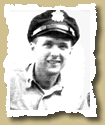| The Assault | Timeline | Maps | Men of D-Day | Photos |

|
The 303rd TC Squadron was the
second squadron to take off from station 488 just before midnight
on 5 june 1944 on mission Neptune carrying paratroopers and bundles
to a designated DZ not far from Ste. Mere Eglise on the East side
of Cherbourg Peninsula. There were nine (9) planes in V of Vs formation.
I was the last plane and was in the left wing position of the last
element. My chalk number was « 18 ». I was
carrying 16 paratroopers and 5 bundles in pararacks, THE CRASH LANDING The plane did not take fire and we all walked out the door. The right wing was torn off in landing but the fuselage was more or less intact. We immediately destroyed our IFF set by detonating it, our Radar with the ax. Charlton destroyed the bomber code and the colors of the day ; we ate the eatable paper overlays but we did not burn the plane for fear of detection. We landed about 0245 June 6 1944. We did not know where we were but thought we might be in friendly territory. It later proved that we were near a small village called Montaigu North of Valognes. THE HIDE OUT Leaving the plane we each had a full canteen of water, our escape kits and purses and our side-arms, Schultz had a tommy gun with plenty of ammunition, the rest of us had .45 caliber pistols which we kept all the time. We had no blankets, only our clothing and rain coats and were cold at night. We stood no watches because no one came near us. However one of us was usually awake. For the first two and one half days we did not eat or drink. After that we used the water in the canteens which lasted until the sixth day. For food we opened one escape kit and used the milk tablets. On the sixth day Loeb found a stagnat pool a short distance away and brought back some water which we strained through handerchiefs and drunk after putting halazone tablets into it. On the eight day Loeb had to go a little further for water and found a French boy about 19 milking a cow. Loeb, seeing he was observed, spoke to the boy, told him he was an American and ask for food and drink. The boy took him to a farm house where he was given eggs, bread and butter and milk. When Loeb told the boy's mother about his companions she gave him a quart of milk and some egg sandwiches to take back. After this Loeb got food and milk every other day from these people. Charlton and I remained hidden all the time. The boy and his mother proved their friendship the first night when Loeb went out near their house and was motioned away because they had a German Captain at the house. On the evening of June 20 these French people told Loeb that American soldiers had passed by and gave Loeb some American cigarettes and K-rations. We all came out of hidding then for the first time, went to the French farm house where we were given a good meal. We returned to our hidding place for the night, went back the next morning to the farm, were given a big breakfast and introduced to another French man who took us to the village of Saussemesnil, East and slightly North of Montaigu. At Saussemesnil we contacted American soldiers of the 4th division, I think they were the 12th AA Battalion. They started us on our way through Valognes, Montebourg and on down to Ste Mere Eglise near which we found a landing strip, after seeing two C-47s coming in with their wheels down. Here we met Colonel Roberts of IX TCC who brough us back to Membury. From there the 436th TC Group flew us down here. Our photographs were taken at Membury by an officer whose name I do not know, but we were not interrogated. COMMENTS PURSES : We gave the money in one purse to the lady and her son at the farm. The money in another purse we gave to the Frenchman who guided us to the American CP at Saussemesnil even though he was very reluctant to take it. FRENCH ATTITUDE : The native
where we were, were friendly as is shown by their treatment of us.
We heard stories from an officer and some paratroopers, all Americans,
who we met on the way out. THE LINE : Yesterday the line was fluid. Our troops were not in contact with german ground forces and did not know just where they were. We were shelling German positions. Germans were shelling our positions near Valognes, along the road between their and Montebourg and south of Montebourg. BRIEFING : Our briefing on what to do in case of a crash landing was good. We did just what we were told to do and came out all right. SUGGESTIONS : John J. Prince (June 22, 1944) |
| |
